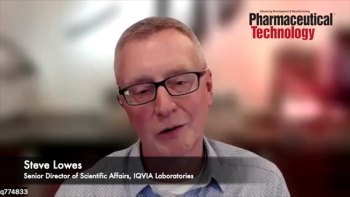
- Pharmaceutical Technology, April 2023
- Volume 47
- Issue 4
- Pages: 40-41
Considerations for Analytical Testing for E&L
Considering the differences between small- and large-molecule drug products can help determine analytical testing methods for E&L.
Analyzing extractables and leachables (E&L) is paramount to ensuring the safety of a drug product and determining any toxicological risks. Examining extractables can help identify potential risks of leachables contaminating or affecting the quality of a drug product. Extractables can be extracted through the use of solvents under certain extraction conditions or can be forced out with high heat without solvents. Extractables may be potential leachables, but not all extractables leach into drug products. Leachables migrate from the container into the drug product or directly to the patients under normal storage or use (1).
Potential sources of leachables include primary packaging components, secondary packaging components, intermediate manufacturing components, or APIs. There are also E&L that can be introduced from the component molding process and can end up becoming a leachable, such as mold release agents or lubricants (1).
Regulations and guidelines
Various regulatory guidelines have been published due to the potential safety risks that leachables pose. FDA published a guidance included in the Code of Federal Regulations (CFR) Title 21 that highlights guidelines on drug product containers and closures, such as:
- “Drug product containers and closures must not be reactive, additive, or absorptive so as to alter the safety, identity, strength, quality, or purity of the drug beyond the official or established requirements.
- “Container closure systems must provide adequate protection against foreseeable external factors in storage and use that can cause deterioration or contamination of the drug product.
- “Drug product containers and closures must be clean and, where indicated by the nature of the drug, sterilized and processed to remove pyrogenic properties to assure that they are suitable for their intended use. Such depyrogenation processes must be validated,” (2).
The United States Pharmacopeia (USP) also published USP General Chapter <665> Plastic Components and Systems Used to Manufacture Pharmaceutical Drug Products and Biopharmaceutical Drug Substances and Products in 2022, which will come into effect in 2026 (3). The document highlights analytical methods of risk assessment of E&L, including biologic drugs.
The Product Quality Research Institute (PQRI) published two industry guidance documents, titled Safety Threshold and Best Practices for Extractables and Leachables in Orally Inhaled and Nasal Drug Products (4) and Safety Thresholds and Best Demonstrated Practices for Extractables and Leachables in Parenteral Drug Products (Intravenous, Subcutaneous, and Intramuscular) (5) that highlight industrial details on how E&L assessments should be performed. The combination of both regulatory and industrial guidance documents provides a fleshed-out guideline for E&L analysis.
Differences between small- and large-molecule drugs
Leachables can interact with small-molecule and large-molecule drugs in different ways, which is a key consideration when testing for E&L in biologics versus small molecules. Biologics can be immunogenic, and a leachable may interact with a protein and trigger an immune response (6). The efficacy of a biologic drug may also potentially be reduced through interactions of leachables with drug molecules through post-translational modification biochemical reactions, such as oxidation, aggregation, or unfolding, explained Lester Taylor, pharma marketing manager at Agilent (7).
Biologic drugs are sensitive and complex. Extractables or potential leachables that may migrate into a drug product have the potential to interact, and therefore, affect the product quality, safety, or stability, explained Fran DeGrazio, vice-president, global scientific affairs and technical services, West Pharma. Additionally, large molecules have greater surface areas, and interactivity can lead to conformational modifications and other interactions that may impact product quality (7).
A main concern for leachables in small-molecule drugs is the specific toxicity/genotoxicity profiles, said Dr. Wayland Rushing, senior scientific advisor at ABC Laboratories. However, with biologics, there is also the concern of the ability of the leachable to interact with the biologic product itself. Many biologics are very sensitive to metal content. As a result, additional monitoring of the metal content may be required (8).
Detecting E&L
Key components such as semi-volatile organic compounds, non-volatile organic compounds, volatile organic compounds, and metals can be identified during an E&L study. For extractable studies, exaggerated conditions are often used to emulate a “worst-case scenario,” and the data are used to help determine what further studies are needed to mitigate future risks. Examples of analytical techniques used to detect E&L include gas chromatography mass spectrometry, liquid chromatography mass spectrometry, and inductively coupled plasma-mass spectrometry (9). Taking these differences into consideration can help identify the right tests to use for detecting E&L.
References
1. Yu, X., and Wood, D. Analytical Testing—Extractables and Leachables
Testing for Pharmaceutical Products. Pharmaceutical Outsourcing. Dec. 7, 2017.
2. CFR Title 21, 211.94 (Government Printing Office, Washington, DC).
3. USP. General Chapter <665>, Plastic Components and Systems Used to Manufacture Pharmacueitcal Drug Products and Biopharmaceutical Drug Substances and Products. USP–NF (Rockville, MD, 2022).
4. PQRI. Safety Threshold and Best Practices for Extractables and Leachables in Orally Inhaled and Nasal Drug Products. Sept. 8, 2006.
5. PQRI. Safety Thresholds and Best Demonstrated Practices for Extractables and Leachables in Parenteral Drug Products (Intravenous, Subcutaneous, and Intramuscular). Sept. 9, 2020.
6. Moffatt, F. Extractables and Leachables in Pharma-A Serious Issue. (Solvias, accessed March 9, 2023).
7. Siew, A. E&L Risk Assessment for Biologic Drug Products. BioPharm Intl. Aug. 1, 2018.
8. Hernandez, R. Special Considerations for Extractables and Leachables Testing in Biological Products. PharmTech. Feb. 2, 2015.
9. Thermo Fisher Scientific. Extractables and Leachables: Regulatory Requirements for Vaccine and Biologic Products. (Thermo Fisher Scientific, 2015).
About the author
Alivia Leon is assistant editor for Pharmaceutical Technology.
Article details
Pharmaceutical Technology
Vol. 47, No. 4
April 2023
Pages: 40-41
Citation
When referring to this article, please cite it as Leon, A. Considerations for Analytical Testing for E&L. Pharmaceutical Technology 2023 47 (4).
Articles in this issue
over 2 years ago
Balancing Change and Certainty in Manufacturingover 2 years ago
Formulating Drugs for Continuous Processingover 2 years ago
Quality Challenges Associated with Cryo/Lyoprotectantsover 2 years ago
Packaging Becomes More Sustainableover 2 years ago
Accepting Alternative Approaches to Freeze Dryingover 2 years ago
A New Hope for Children Living with HIVover 2 years ago
Kudos and Hurdles in Tackling Rare Diseasesover 2 years ago
Changes Afoot in Pharmaceutical Laws and Regulations in SpainNewsletter
Get the essential updates shaping the future of pharma manufacturing and compliance—subscribe today to Pharmaceutical Technology and never miss a breakthrough.




